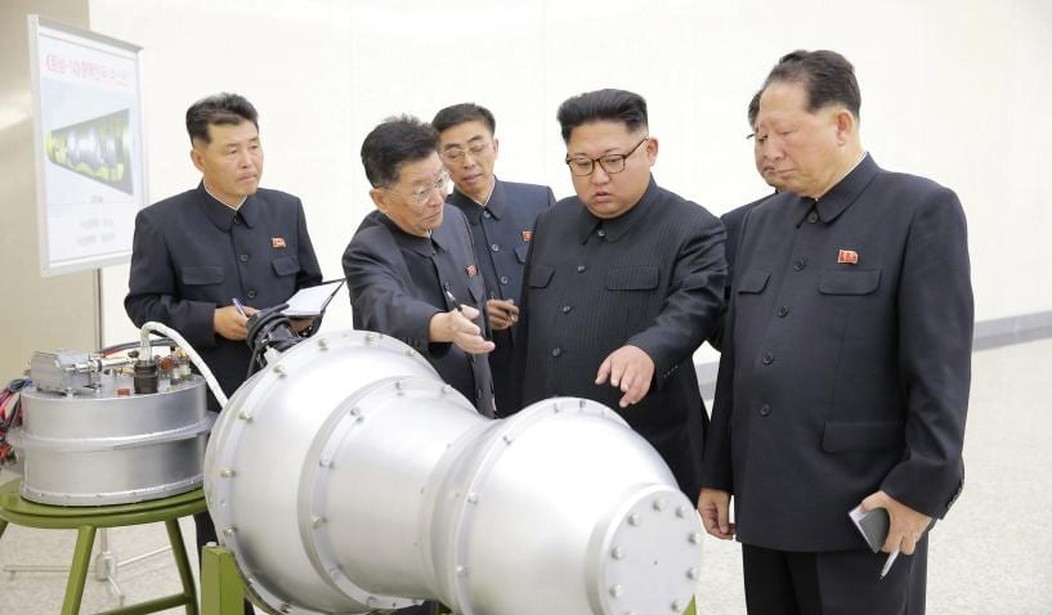North Korea’s news agency is claiming that the country has successfully loaded a hydrogen bomb onto an ICBM. Meanwhile, the Hermit Kingdom’s leader, Kim Jong Un, has threatened to launch a electromagnetic pulse (EMP) attack on the United States and there are late reports of one, and possibly a second, earthquake that most likely indicates a North Korean nuclear weapons test. The Chinese are saying the second earthquake may be a cave-in caused by the test.
#BREAKING USGS records 6.3-magnitude "explosion" 24 kilometres (15 miles) east northeast of Sungjibaegam in North Korea
— AFP news agency (@AFP) September 3, 2017
Early reports say this could be North Korea's largest nuclear test yet. Possibly a megaton yield, indicating a staged thermonuclear weapon. https://t.co/Fj0j7TqpkS
— Missile Defense AA (@MissileDefAdv) September 3, 2017
North Korea earthquake appears bigger than those caused by previous nuclear tests pic.twitter.com/EOkb08yxLm
— Alastair Gale (@AlastairGale) September 3, 2017
There’s no confirmation of the North Koreans’ ability to build a thermonuclear device or place it on top of an ICBM. Recent North Korean ICBM missile tests have ended in failure.
Yonhap News Agency reports:
North Korea has developed a hydrogen bomb which can be mounted on a new intercontinental ballistic missile (ICBM), Pyongyang’s state media claimed Sunday.
North Korean leader Kim Jong-un inspected the loading of an “H-bomb into the ICBM during his visit to the Nuclear Weapons Institute, according to the Korean Central News Agency (KCNA).
“The institute recently succeeded in making a more developed nuke, true to the strategic intention of the Workers’ Party of Korea (WPK) for bringing about a signal turn in nuclear weaponization,” the KCNA said.
KCNA also claimed that the “super explosive power” of the hydrogen bomb could range from “tens kiloton to hundreds kiloton.”
Kim Jong Un Gives Guidance to Nuclear Weaponization pic.twitter.com/vliu0rsJgI
— Dave Schmerler (@DaveSchmerler) September 2, 2017
Reuters states that President Donald Trump and Japanese Prime Minister Shinzo Abe talked by phone about the “escalating” nuclear crisis in response to the North Korean claims.
Even more troubling is that Kim is threatening the capability of a catastrophic EMP attack that could be directed at the U.S.
Should the U.S. be afraid of a N. Korean electromagnetic pulse attack? Here's the case for YES.@38NorthNK https://t.co/IfOBtNZZaE
— Jonathan Cheng (@JChengWSJ) September 3, 2017
According to the Wall Street Journal:
Mr. Kim also specifically cited the possibility of an electromagnetic pulse, or EMP, attack. Fears of an EMP strike by North Korea have circulated for years among some U.S. policy makers, though others have openly dismissed the possibility of Pyongyang launching such a strike.
In an EMP attack, North Korea would conduct a high-altitude nuclear detonation over the continental U.S. The detonation could emit a brief but powerful electromagnetic signal capable of disrupting swaths of the U.S. electrical grid, experts say.
Ms. Hanham said while such an attack was theoretically possible, the North’s goals made it more likely that Pyongyang would try to follow through on its threat to send a nuclear-tipped missile into a large American city.
Again, the North Korean claims have not been confirmed.
In photos, North Korea signals a more powerful ICBM in the works https://t.co/kcCIM6juXR pic.twitter.com/GKQSa6kdER
— Reuters (@Reuters) August 24, 2017
Earlier this summer, Joint Chiefs of Staff Vice Chairman Gen. Paul Selva raised questions about the reliability of North Korea’s ICBM.
Gen. Selva said there are several technical hurdles they have to overcome.
First, North Korea would have to deploy a guidance and stability control system that could direct a long-range missile thousands of kilometers accurately without breaking apart, Selva said. Second, it needs a reentry vehicle housing the warhead that can survive the heat and stresses of an intercontinental ballistic launch. Third, it needs a nuclear weapon “that is small enough and stable enough to survive the trip,” he said.
If, in fact, the North Koreans do have an operational hydrogen bomb that they have successfully miniaturized for an ICBM, it would make the EMP threat real.
And yet the media’s favorite experts have derided the prospect of an EMP threat.
Take, for instance, this dismissive exchange from an April NPR report.
STEVE INSKEEP, HOST: And let’s follow up on a warning about U.S. security. Former CIA Director Jim Woolsey laid it out yesterday on this program talking of one way that North Korea could use a nuclear device.
(SOUNDBITE OF ARCHIVED BROADCAST)
JAMES WOOLSEY: The really dangerous thing is that they can both orbit satellites – they’ve orbited several – and use nuclear weapons. And if they detonate a weapon up some miles above the Earth in a satellite, they can knock out a major share of our electric grid.
INSKEEP: Well, that sounds scary, so we asked NPR’s science editor Geoff Brumfiel to evaluate that threat.
GEOFF BRUMFIEL, BYLINE: Officially, it’s called an electromagnetic pulse or EMP.
(SOUNDBITE OF FILM, “GOLDENEYE”)
JUDI DENCH: (As M) Set off a nuclear device in the upper atmosphere, creates a pulse, a radiation surge that destroys everything with an electronic circuit.
BRUMFIEL: That’s from the James Bond film “GoldenEye.” There is something Bond-like about a bomb that would create a power surge and fry all our modern gadgets. So I Skyped Jeffrey Lewis, a nuclear weapons expert at the Middlebury Institute of International Studies and asked him, could North Korea really do this?
JEFFREY LEWIS: (Laughter).
BRUMFIEL: Take that as a no.
LEWIS: This is the favorite nightmare scenario of a small group of very dedicated people.
It remains to be seen if this is just a “Golden Eye” fictional scenario confined to a “small group of very dedicated people.”
In related news, Somali officials this week asked for U.S. assistance after al-Shabaab took over uranium mine in that country, with the uranium possibly headed to Iran and their nuclear program.
Al Qaeda affiliate mining uranium to send to Iran, Somali official warns US ambassador
https://t.co/3kSKWOl5MY— Fox News (@FoxNews) August 31, 2017
.@FoxNews : Daesh affiliate in Somalia captured uranium mine & planning 2 send uranium 2 #Iran looks like #Irandeal is going swimmingly well pic.twitter.com/WewHBc64Ry
— Oubai Shahbandar (@OS26) September 1, 2017








Join the conversation as a VIP Member